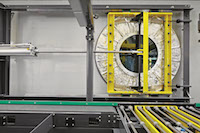Festo’s CPX platform – complete automation solution
Much like the mainland Britain, Guernsey has been ravaged by the forces of nature this year. But thanks to a remotely controlled, pneumatically operated pumping station that was completed last year, one area of the island has escaped damage from the resulting floods.
On February 3rd this year (2014) Guernsey faced one of its wettest and windiest days in recent memory. Heavy rain fell throughout much of the day and by the evening Guernsey Airport had recorded 32.5mm – more than an inch – of rainfall, flooding many of the island’s major roads, making several impassable and causing widespread disruptions.
Both local radio stations were forced off air as the FM transmitter was flooded, with TV signals being unavailable for part of the night. According to Guernsey Police more than 60 roads were flooded – which outpaced the number of closed signs available. Sandbags also ran short as authorities scrambled to contain the worst of the weather.
But thanks to improvements at the Marais Stream pumping station one area of the island emerged virtually unscathed from the onslaught. The pumping station, situated off les Banques not far from the capital of Guernsey, St Peter Port, is part of a network of facilities that form Guernsey Water’s infrastructure for the catchment, storage and transfer of raw water for the production of the island’s drinking water.
“Without a doubt we would have suffered big issues this winter with the heavy rainfall if we hadn’t undertaken the work there,” Andy Benstead, Water Production Manager, at Guernsey Water says. “I can guarantee that there would have been problems if we hadn’t upgraded it.
“We don’t actually have rivers in Guernsey they are all classified as streams; the Marais Stream has a fair catchment area and it includes a bank and an insurance company, and without this work they would have been flooded.”
The work at the pumping station was an upgrade; the whole infrastructure was changed apart from an old tank that remained. “There were two reasons for the upgrade, part age and part because the area had suffered from a flooding problem,” Benstead adds. “The equipment is much bigger, more reliable, easier to control and we can now pump up to 1000 litres a second.”
Marais Stream pumping station was originally built in 1938 and required an upgrade to allow an increased volume of water to be collected and delivered to the nearby water treatment works with less going to waste.
Geomarine, a local civil engineering contractor, was contracted by Guernsey Water to carry out these improvement works as part of on-going works on the island’s infrastructure. Before the project was started all that was on site was a holding tank and pump house.
Marais Stream collects the run-off water from the local area and this is fed via the three inlet penstocks through fine screens that remove debris that would damage the pumps in the pumping station. The water is then pumped either into the treatment works or, in the case of heavy rainfall such as earlier this year, can be diverted and discharged straight into the sea.
The pumping station is the first on the Island which could be considered ‘multifunctional’, as it incorporates three vital elements. Firstly, raw water (rainfall) is caught and transferred into Longue Hougue reservoir for conversion into drinking water. Secondly, stream water is used to maintain the cleanliness of the screens at the new Belle Greve Wastewater Treatment Centre. Finally, the new pumping station enables excess water to be pumped out to sea, which might otherwise overload the capacity of the Barker’s Quarry Reservoir and lead to localised flooding.
“Festo supplied three pneumatically operated penstocks, driven by linear actuators, to isolate the flow; these were located in the incoming channel,” Tony Gillard, Business Development Manager at Festo explains. “DNC cylinders with rod clamps are used to control the raising and lowering of the penstocks. These distribute the incoming water into the storage basins. From the storage basins, the water is distributed to various parts of the site by butterfly valves operated by pneumatic quarter-turn actuators.”
The entire system is run by Festo’s CPX remotely operated control system. The site itself is unmanned and is controlled via the SCADA system from the Guernsey Water Offices based five miles away. “The CPX platform is a complete automation solution that integrates a wide choice of pneumatic and electrical, analogue and digital I/O,” Gillard explains. “CPX systems configured for specific requirements are delivered pre-built, tested and ready for installation, enabling system integrators to meet tight deadlines and budgets. For additional flexibility, the CPX platform can operate as either a self-contained industrial PLC, or as a local unit on a Fieldbus or Industrial Ethernet-based distributed system. In addition, a wide choice of I/O and connector modules makes interfacing to process sensors and actuators easy.
“Remote operation is becoming more common; with pneumatic control you have the functionality to remotely operate the system,” Gillard adds.
Unusually for the water treatment sector is the selection of pneumatically controlled valves rather than electric. “On Great Britain it is more usual to have electric actuators but the advantages of pneumatics are beginning to sway the market,” Gillard says. “In most other applications, such as petro chemical and industrial applications, pneumatics are the preferred solution, but for some reason in water treatment and sewage plants electric actuation is still predominant for now.”
Pneumatic automation presents an extremely reliable alternative to electrical automation systems and reduces the costs of investment, installation and operation compared with conventional electrical installations.”
Guernsey Water has gone down the path of changing electric actuators to pneumatic and is reaping the benefits. Pneumatic control delivers energy saving, ease of installation, safety and reliability, because of less moving parts, as well as being faster to operate and easier to control.





 Posted by Eoin Ó Riain
Posted by Eoin Ó Riain 












